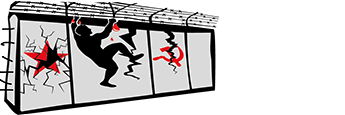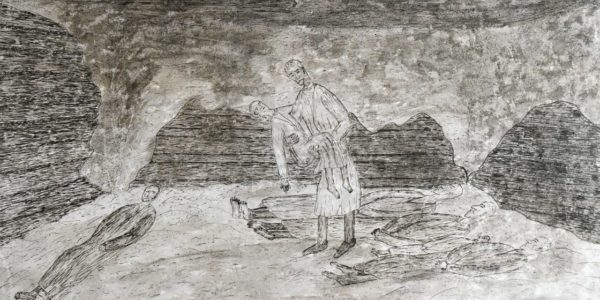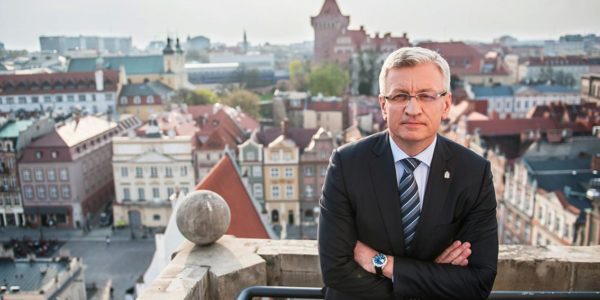By Beata Bruggeman-Sekowska
65 years ago on the 28 June of 1956, at 6 a.m. Poznań ( city in the western part of Poland) riots started at the multifactory complex of Joseph’s Stalin’s (or ‘Cegielski’s) Metal Industries. Approximately 100,000 people gathered in the city centre near the local Ministry of Public Security building demanding better working conditions and better wages. Konstantin Rokossovsky (a former Soviet officer), ordered the local military commander to suppress the uprising. In the riots about 400 tanks and 10,000 soldiers were supressing the protesters. It is estimated that between 57-100 protesters, including a 13-year-old boy, Romek Strzałkowski were murdered by communists, hundreds were injured. All the information concning Poznań events was censored for a quarter of a century.
De-Stalinization and Secret Speech
On February 25, 1956 Khrushchev, first secretary of the Communist Party of the USRR delivered the so called ’’Secret Speech’’ based on the report ‘’On the Cult of Personality and Its Consequences’’ after the official part of the 20th Congress of the Communist Party of the Soviet Union. He strongly criticized the rule of Joseph Stalin and especially purges in the 30s. He accused Stalin of creating a cult of personality. The speech was met with applause, but there are reports that some participants suffered heart-attacks or committed suicide. The speech had serious implications.
It is believed to be the main cause of the Sino-Soviet split by China and Albania.
The process of de-Stalinization initiated various debates in the Eastern bloc countries. On March 12 1956 Poland’s hardline Communist leader Bolesław Bierut dies allegedly resulting from shock at the content of the Secret Speech.
Demands
Poznań was one of the largest urban and industrial centres of the Polish People’s Republic. The workers were complaining about their life conditions, demanding wage increases, lower food prices, and less-demanding work quotas. Since local directors were not able to make any changes workers sent letters and delegations to the Polish Ministry of Machine Industry and Central Committee of Polish United Workers’ Party but no change was introduced.
Around June 23 a delegation of about 27workers was sent to Warsaw and after three days they returned to Poznań, confident that some of their demands were accepted. However, the next morning the Minister of Machine Industry met with the workers and withdrew several promises that their delegation had been given in Warsaw.
On June 28, 1956 a strike started at 6 a.m. at the multifactory complex of Joseph Stalin’s (or ‘Cegielski’s) Metal Industries. Around 80% of its workers marched towards the center of Poznan. Workers at other plants, institutions and students joined the procession.
Between 9 and 11 a.m around 100,000 protesters gathered on the Adam Mickiewicz Square surrounded by buildings occupied by the city and Party authorities and police headquarters. They demanded lower food prices, wage increases and the revocation of some recent changes in the law that had deteriorated workers’ conditions. Most of them had lost bonus pay in June as the government suddenly raised the required work quota.
Course of Events: Black Thursday [1]
About 10.00 am: A group of protesters enters the building occupied by the provincial committee of the communist party and takes down the red flags. Another group of demonstrators enters the police headquarters building and talks the police officers into joining the protest. A rumor spreads through the crowd about the alleged detention of the workers’ delegation. The protesters decide to set the delegates free – groups of protesters head towards the prison at Młyńska street and Kochanowskiego street – to the building of the Security Office. On their way to the security office building, the protesters throw devices used for jamming Western radio programmes down from the roof of the Social Insurance Institution at Dąbrowskiego street.
About 10.15 am: Protesters gather at Kochanowskiego and Młyńska streets.
About 10.50 am: Protesters use ladders to claim the wall, then open the prison gate from the inside and let the prisoners out.
About 11.00 am: First shots are fired from the windows of the Security Office, and first wounded are transported to Pawłow hospital and Raszeja. hospital.
11.00 am – 2.00 pm: At Młyńska street, protesters enter the District Courthouse and the Prosecutor’s Office, their files being thrown out into the street and burnt.
About 11.00 am: The Commander of the Officer School of Armoured and Mechanised Formations sends 16 tanks, 2 armoured personnel carriers and 30 vehicles to protect the designated buildings. Some of them are seized by protesters, their crews disarmed. Combat alert for the whole 2nd Armoured Corps quartered at the Biedrusko military training ground near Poznań. In the area of Kochanowskiego street the exchange of shots escalates around the besieged building of the Security Office. The building is shot at from more than 20 places.
About 11.30 am: Arms warehouse at the prison building is seized.
2.00 – 6.00 pm: About 2.00 pm the Deputy Minister of National Defence, general Stanisław Popławski arrives at the Ławica airport and takes over the command of city pacification. After 4.00 pm units of the 2nd Armoured Corps enter the city. At that time groups of protesters seize weapons from a few institutions. Demonstrators disarm the Civic Police stations in Junikowo and Wilda, as well as police stations in Swarzędz and Puszczykowo, in the vicinity of Poznań.
By 6.00 pm units of 19th Armoured Division of the 2nd Armoured Corps enter Poznań.
6.00 – 9.00 pm: Protesters seize weapons from the Prisoners’ Camp in Mrowino, the Military School at the Poznań University of Technology and the police station in Mosina. In the evening, an attempt at disarming a police station in Czempiń ends in a shooting.
Fights with the security forces continue in Poznań, mainly around the Security Office building. At about 8.00 pm units of the 10th Armoured Division of the 2nd Armoured Corps enter the city. At 9.00 pm a police curfew is enforced in Poznań; it lasts until 4 am next day.
Detention, investigation and trials
In the evening of June 28th 1956 detentions and reprisals were started. By August 8th 746 persons were subject to apprehension or mass detention.
The cases of torturing and beating were reported. Some protesters were so severely beaten that the prosecutors either released them from prison or scheduled for later time in order to avoid showing them in court.[2]
The investigation was concentrated on proving the thesis put forward by communist authorities saying that the riots were pre-planned, carried out and supervised by American and West German secret services and reactionary underground. The most famous show-trials, the so-called “trial of three”, “trial of nine” and “trial of ten” began in September and October 1956. The prosecutors were expected to produce evidence to conceal the fact that a vast majority of defendants were young Poznań workers and point out that they were hooligans and criminals.
Due to the presence of international public opinion, defenders were able to defend the protesters and the Poznań trials ended with relatively lenient sentences, considering those times. [3] The defendants faced serious repressions for protecting the protesters and expression the criticism of the system.
Information concerning Poznań events was censored for a quarter of a century. Communists chose a new leader Władysław Gomułka who was considered moderate and wage rises and other reforms were announced. This process was called Polish October or ‘’Gomułka Thaw”. Gomułka’s regime, though, gradually became more oppressive.
Image: public domain, wikipedia. ”We demand bread”.
[1] https://www.poznan.pl/mim/czerwiec56/pages.html?co=list&id=3043&ch=3060&instance=1017&lang=en&lhs=czerwiec56
[2] https://www.poznan.pl/mim/czerwiec56/en/trials,p,3043,3782,3784.html
[3] https://www.poznan.pl/mim/czerwiec56/en/trials,p,3043,3782,3784.html
First published on: https://www.communications-unlimited.nl/poznan-protests-of-1956/ and republished with permission



Follow Us!